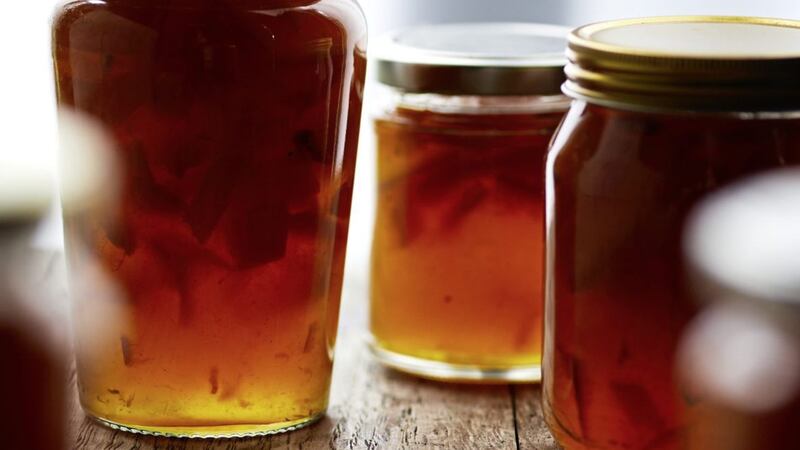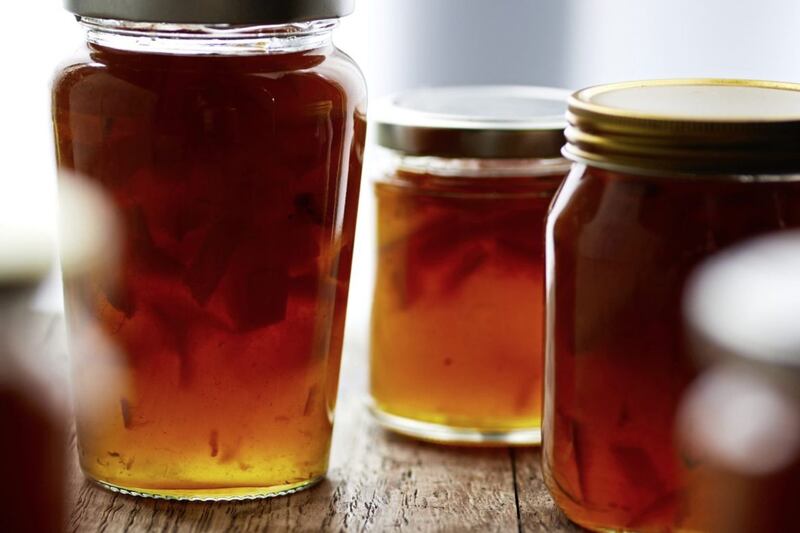MARMALADE is admittedly not to everyone’s taste. Too bitter, too lumpen, too chewy, too astringent. Paddington arguably has quite a bit to answer for.
He (and his creator Michael Bond) – like Winnie the Pooh, AA Milne and honey before him – made the stuff seem magical, essential, delicious. He pulled sandwich after sandwich out from beneath his red hat, making us hanker for a bite. But many a child has bitten into one such sandwich and felt betrayed by the bear from Peru.
It is often only later – as it was for me – that the bitter appeal begins to make sense, and even then, it’s quite the hurdle at first to switch from peanut butter and jam, or (shock horror) Nutella, to the amber sludge of marmalade (a generous smear of real butter between bread and preserve definitely helps the habit stick).
Usually my marmalade supply comes courtesy of my boyfriend’s mum. She delivers it in old wax-topped Bonne Maman jars; jars that have been so well used over the years, the entirety of the labels have peeled off. But with so many pandemic-induced breakfasts spent at home, demand has increased beyond reasonable production levels, and using the barest smidge of marmalade to make a jar last is, frankly, untenable. So this January, smack bang in the middle of Seville orange season (December to February), I decided it was time to scrabble together a batch myself.
You’d think it would be relatively straightforward: pick a recipe, boil some oranges, whack it in jars. But once you start reading up on marmalade and comparing recipes, and then comparing those to your own (very specific) idea of what marmalade ought to be, the whole process becomes soupy with nostalgia, research and hope. You’re essentially jarring sunshine to unspool through the year.
Heading to the kitchen is fundamentally about seeking nutrition, but cooking comes with its own glorious baggage: comfort, encouragement, consolation and crucially, something to do. Seriously, if nothing else persuades you, making one batch of marmalade will easily fill an entire Sunday afternoon – longer if you have children who want to ‘help’.
I begin by reading Lucy Deedes’s beautifully illustrated new recipe collection, The Little Book Of Marmalade, which describes a whole year’s worth of ways to use it. Then I got side-tracked by Claire Thomson’s classic marmalade recipe (her jars seem to glow), and revisited the wise words of jamming queen, Pam Corbin (I trust the woman implicitly).
Then my boyfriend's mum – our marmalade queen – admitted she’d misplaced her own mum’s recipe and in recent years has just followed the instructions on the netted bag of Sainsbury’s Seville oranges (and there have been no complaints).
And so I’d like to tell you that I diligently followed one single recipe, but it seems that when the marmalade making is upon you, much comes down to instinct and, in a pandemic, what’s available in the cupboard. The gist is always roughly the same though: 1.5kg of seville oranges, two lemons, 2kg granulated sugar, a huge slosh of water and much patience, should see you end up with six to eight jars of liquid gold.
Some people use the whole fruit method (the oranges are cooked whole before being chopped), while others shred peel and pith painstakingly by hand (this turns out to be very mindful). Some leave the oranges to sit overnight, others have no patience (among them, me) and so forge onwards in a single day.
It’s while the citrus mix sits and simmers on the hob for two-and-a-half hours (so the peel softens), turning the air of my flat to fragrant steam, that I realise I bought caster sugar by mistake and have to raid my baking shelf for the dregs of anything remotely granulated – this marmalade will be a three sugar type: demerara, white cane, soft brown.
I mean to write down the quantities of each in case this turns out to be the ultimate marmalade of all time, but forget, because once that sugar is in the pan and the orange shreds are roiling to a boil for 15 minutes, it’s hard to do anything but hover and fret manically over setting points. The fridge is full of small plates awaiting the ‘wrinkle test’ (you’ve reached setting point when you can push a spoonful of marmalade on a cold plate and it wrinkles) and the worktops scattered with sterilised jars.
Once you’ve wrangled with a massive pan of molten orange and decanted it into those jars though, the pride and sense of achievement is something else. The alchemy of preserving and jamming has this strange ability to charge your memory. As I put the jars away, ready to be swiped down one by one for their time in the fridge, I think of my granny making crab apple jelly; marmalade on toast before cliff walking in Cornwall; the hope that soon we can trade jars, rather than stealing them off my boyfriend’s mum.
Eating marmalade is a small thing, having the time, energy and ingredients to make your own, a privilege, but if you can, do. Paddington had the right idea all along.
MARMALADE
(Makes 2.5kg)
900g Seville oranges
3 lemons
2kg granulated sugar
Method:
Put the oranges and lemons in a large saucepan and pour over two litres (70fl oz) of water. Bring to a boil over a high heat, then reduce the heat and simmer for two hours. Remove from the heat and leave the fruit to sit in the liquid in the pan for at least six hours, or overnight.
Remove the fruits, leaving the liquid in the pan, and split them in half, scooping out the flesh and pips and reserving these in a bowl. Chop the orange and lemon skins however you like – into fat or thin strips.
Tie the fruit flesh and pips tightly in cheese cloth or muslin (or use any clean cloth). Add the sugar and the chopped skins to the pan with the liquid, along with the cloth tied with the flesh and pips. Bring the pan to a rapid boil over a high heat – be careful it will boil volcanically, so keep a watchful eye – then boil steadily until the marmalade reaches the magic setting point of 105C. When you get to this temperature, boil the marmalade for a further one minute.
Remove the pan from the heat and leave the marmalade to stand and settle for at least 30 minutes before spooning into clean, sterilized jars and sealing tight. The marmalade can last for anything up to a year or more.
From Home Cookery Year by Claire Thomson, photography by Sam Folan, published by Quadrille, priced £30.
RUM AND MARMALADE LOAF CAKE
(Serves 10–12)
175g plus 1tsp butter, softened, plus extra for greasing
100g raisins
100ml/7tbsp rum
175g wholemeal (wholewheat) spelt flour
2tsp baking powder
1tsp ground ginger
1tsp ground mixed spice
175g plus 2tbsp dark muscovado sugar
Finely grated zest of 1 lime
150g marmalade
50g finely chopped stem ginger
3 eggs
To glaze:
2tbsp marmalade
1tbsp rum (optional)
Method:
Preheat the oven to 180C/Gas mark 4. Butter and line a 1kg loaf tin.
Put the raisins in a small saucepan and add the rum. Bring to the boil, then immediately remove from the heat and leave to stand while you make the rest of the cake.
Put the flour in a bowl with the baking powder and spices. Whisk together to combine and remove any lumps. Beat the butter and sugar together in another bowl with the lime zest until very soft, and lightened to the colour of butterscotch. Beat in the marmalade and ginger, then add the eggs one at a time, adding a couple of tablespoons of the flour mixture with each addition. Stir through the rum-infused raisins along with any liquid that hasn’t been absorbed. Scrape the mixture into the prepared loaf tin and bake in the oven for around one hour, until well risen and a rich brown.
For the glaze, melt the marmalade and rum, if using, together in a small saucepan and brush over the cake while it is still warm. Leave to cool in the tin. If you can bear to wrap this up and leave it for a couple of days, it will be all the better for it.
:: From Citrus by Catherine Phipps, photography by Mowie Kay, published by Quadrille, priced £20.




